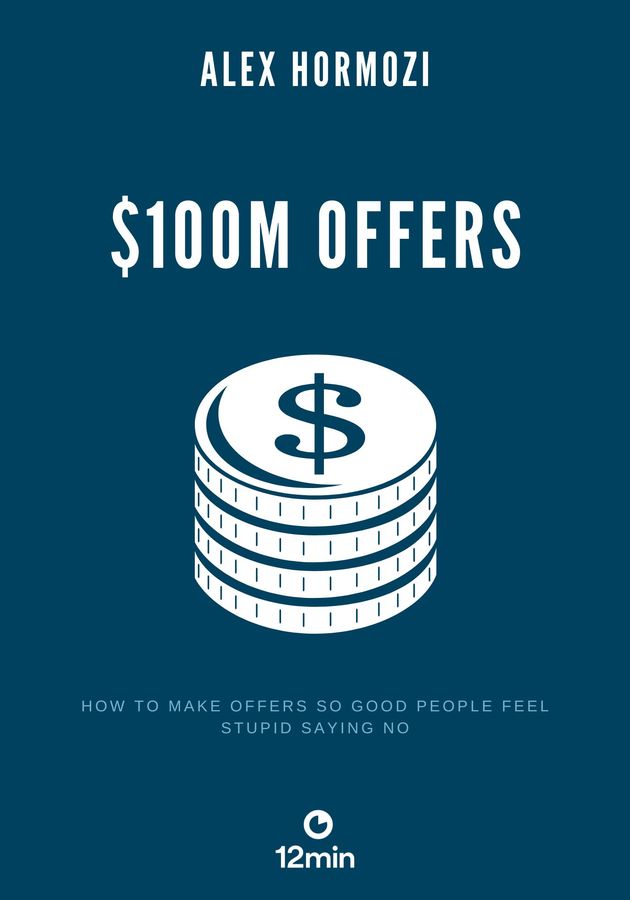In his “2015 Letter to Amazon Shareholders,” Jeff Bezos famously compared business to baseball. “We all know that if you swing for the fences,” he wrote, “you're going to strike out a lot, but you're also going to hit some home runs. The difference between baseball and business is that baseball has a truncated outcome distribution. When you swing, no matter how well you connect with the ball, the most runs you can get is four. In business, every once in a while, when you step up to the plate, you can score 1,000 runs.” This type of outsized returns is what Alex Hormozi’s “$100M Offers” is all about. So, get ready to learn how to make offers others won’t be able to refuse – not because you’re Brando but because you’re Bezos!
Finding the right market – a starving crowd
In order to sell anything, you need demand. You don’t want to be selling ice to Eskimos. Not that you can’t with the right skill, but you won’t be able to earn a lot of money out of it. However, creating demand is not the stuff of sales; finding the right market is. If you don’t have the right market for your offer, then chances are nothing will ever work for you. The right market can be either a great market or a normal market. Finding a great market is, of course, great, but Hormozi is more interested in normal markets – because, after all, they are far easier to find. In his dictionary of success, a “normal market” can be defined as “a market that is growing at the same rate as the marketplace and that has common unmet needs that fall into one of three categories: improved health, increased wealth, or improved relationships.”
When picking your market – be it normal or great – try to look for the following four indicators:
- Massive pain. Right markets are not about wants, but about needs. Meaning, your buyers shouldn’t just want what you are offering, but they must desperately need it, much like one needs a painkiller when suffering from a grueling toothache. If you can articulate the pain your prospect is feeling accurately, and have a product that placates it, they will almost immediately be drawn to your solution. In Hormozi’s words, “The pain is the pitch.”
- Purchasing power. Many people need help with improving their resumes to get more job interviews. However, starting a business offering such service may not be a great idea, because people who need job interviews are usually unemployed. And if you want to make $100M offers, you need an audience able to afford them. So, make sure your targets have the money – not potentially, but in the present.
- Easy to target. Even if you have a perfect market, but no way of finding the people who comprise it, you won’t be able to make money out of it. That’s why, as smart as it might be to build a service for rich donors, unless you can find them all gathered together somewhere, don’t do it. Look for easy-to-target markets, composed of people who, say, visit the same forum, belong to the same social media groups, or have a publicly available mailing list. You’ll make your life a lot easier.
- Growing. Whereas growing markets are like a tailwind in that they make everything move forward faster, declining markets are like headwinds in that they make all efforts harder. You don’t want to be selling horse-carts in the 21st century, because you don’t want your market fighting against you. Not that it’s impossible, but you’ll probably find things easier if you’re selling cars.
Charging what things are worth (i.e., more than they are)
Health, Wealth, and Relationships, in Hormozi’s opinion, are the three main markets and the ones you should always target. No matter how humanity evolves in the future, there will always be demand for solutions to these core human needs, because there will always be tremendous pain when one lacks either of the three. However, as Hormozi says, the riches are in the niches, that is to say, it’s never a good idea to market for general pain, but for specific ache. Hence, in finding a good market, your main goal should be finding a smaller subgroup within the three categories we mentioned – health, wealth, and relationships – which has the buying power, is growing and is easy to target. Then, what you need to do is just stick with whatever you’ve picked long enough to learn from your mistakes. If you try one offer, you’ll probably fail. If, however, you try a hundred offers, you will probably succeed.
Now, most business owners use the same logic to settle on the price of the product or service they are offering. First, they see what everyone else offers, then they take the average, and then they go slightly below to remain “competitive.” But there’s nothing competitive about it, is it? The goal of Hormozi’s $100M offers – which he calls Grand Slam Offers – is to get “more people to say ‘yes’ at a higher price by increasing your value to price discrepancy.” Even more, the goal “isn’t just to be slightly above the market price: the goal is to be so much higher that a consumer thinks to themselves, ‘This is so much more expensive, there must be something entirely different going on here.’” Why would that ever work? In other words, why would anyone pay more money for a seemingly similar product they can buy for less? Well, here’s why.
You see, the reason people buy anything is to get a good deal out of it. Put otherwise, when someone buys anything, they believe that what they are getting from the deal (value) is worth more than what they are giving in exchange for it (price). However – and this is very important – our brains often confuse the two, that is to say, they instinctively add value to things that are more expensive. For example, in a blind taste test, consumers repeatedly ranked the most expensive of three offered wines as being the best, despite being given the exact same wine three times by the researchers. So, in essence, raising your prices means enhancing the value as well. Moreover, since people want to buy expensive things, the higher your price, the more allure your product or service will have. And that’s the virtuous cycle of pricing: getting more customers by charging more.
Grand Slam Offers and the value equation
Grand Slam Offers are not just about high prices: they are about high prices that differentiate. You don’t want to be just a little more expensive than your competitors, but a lot. Being a little more expensive makes you look contemptible; however, being a lot more expensive than everybody makes you look classy, it puts you in “a category of one.” Just think of Apple. Can you honestly and objectively say they offer so much more than their competitors? Not really. But they’ve mastered the art of the Grand Slam Offer. To finally define it, using Hormozi’s words, a Grand Slam Offer is “an offer you present to the marketplace that cannot be compared to any other product or service available, combining an attractive promotion, an unmatchable value proposition, a premium price, and an unbeatable guarantee with a flexible money model that allows you to get paid to get new customers.”
Most of the stated elements of the Grand Slam Offer are self-explanatory; even so, to some of them we’ll return later. For now, let’s see what “an unmatchable value proposition” means, or rather how value is created. There are four primary drivers of value. They are:
The dream outcome. In the mind of your buyer, the first tenet of value creation corresponds to the question “What will I get out of it?” In essence, it is the gap between one’s current reality and their expectations. These expectations are always rooted in deep, unchanging needs and desires. Hence, your goal should be twofold. First, you need to accurately depict your prospects’ dreams back to them, and then, you should explain how your product or service will get them there. For example, rather than selling anti-aging creams or fitness, sell a perception of beauty. It’s nobody’s dream to go to the gym; however, it’s the dream of many people to be perceived as beautiful.
Perceived likelihood of achievement. The second tenet of value creation corresponds to the question “How will I know it’s going to happen?” People value certainty. Hence, they will pay more to be the 10,000th patient of a plastic surgeon than their first. So, merely by increasing your prospect’s belief that your offer should work will you make it much more valuable. Thereby, you’ll be more likely to charge a premium for it – and get away with it!
Perceived time delay between start and achievement. “Time delay” relates to the question, “How long will it take?” It can be defined as “the time between a client buying and receiving the promised benefit.” Naturally, the shorter the distance, the more valuable the product. Hence, in addition to selling long-term value (the dream outcome), make sure to sell short-term experiences as well, that is to say, little milestones that guide your prospects along their way to satisfying their needs. For example, if you’re selling a gym membership, don’t just sell the dream of a biking body in a year – sell also the little milestones of increased community of friends, more day-to-day energy and higher sex drive!
Perceived effort and sacrifice. Finally, to increase the value of your offer, you must try to decrease the ancillary costs. Your prospects’ last question related to the value of your product will always be, “What is expected of me?” The more effort they must put into making things work, the less they will want to buy your product or service. For example, selling liposuction might be easier than selling gym membership, because the latter asks for a lot of effort and sacrifice to reach the same dream outcome.
Creating and enhancing your Grand Slam Offer
A Grand Slam Offer makes every effort to increase the dream outcome and the perceived likelihood of achievement, while decreasing the time delay and the perceived effort and sacrifice. The keyword here is “perceived”. Remember, humans are irrational beings, so much more than in facts, they are interested in stories. Hence, as that famous movie quote goes, “when the legend becomes fact, print the legend.” It doesn’t matter whether exercising more increases sex drive – what matters is that you make your prospects believe it does. Of course, Grand Slam Offers should never be about selling snake oil, but should always have in mind different ways of enhancing your value proposition. Crafting your Grand Slam Offer starts there, in that simple revelation. Let the following few steps guide you through the rest of the process:
- Identify the dream outcome. Let’s go with the example we already brought up, and let’s make the dream outcome a bikini body. To increase the value of your proposition, decrease the time delay, that is to say, promise the realization of this dream in the span of, say, 6 weeks. That way, you’ll stop selling a gym membership card, and you’ll start selling next year’s summer vacation – which is why people want bikini bodies in the first place.
- List problems. Write down all the things people struggle with when it comes to weight loss and exercising, such as buying, cooking and eating healthy food or showing up for their training sessions. The more problems you can think of, the better.
- List solutions. Now it’s time to turn your prospects’ problems into solutions. Think, “What would you need to show someone to solve this or that problem?” For example, can you prepare a detailed list of healthy food with a science-backed diet regime? If cooking said food is the bigger problem, does pre-made Instacart delivery solve the problem? You get the drift. The point is to think of as many solutions to the detected problems as you can.
- Create your solutions delivery vehicles. The next step is thinking about all the things you can do to deliver the solutions you’ve come up with. Aim to decrease your prospects’ efforts and sacrifices. The easier you make it for them, the more interested they will be in what you offer. Can you deliver your meal plans to your prospects’ doorstep? Will a subscription service and a personal trainer solve most of the things you’ve thought of? Those are the questions you need to ask yourself.
- Trim and stack. Now it’s time to trim down all of the ways you can deliver your solutions to only the things that are the highest value to your prospects and the lowest cost to you. So, see if there is a lesser version of the all-in experience that you can deliver at scale. Don’t worry about the price for now. Let your prospects worry about it.
- Enhance your offer. By now, you should have your pitch. Say, getting a bikini body in six weeks by eating healthy and exercising regularly thanks to a simple meal-plan service and a customized workout regime. To make that offer even better, enhance it. The following five things are the best enhancers: scarcity, urgency, bonuses, guarantees, and naming. With relation to the last, it’s best to follow Hormozi’s trademarked M-A-G-I-C formula: 1) make up a magnetic reason, 2) announce an avatar, 3) give your prospects a goal; 4) indicate a time interval; and 5) complete it with a container word. Here are two seemingly simple, but great examples, “Free Six-Week Lean-By-Halloween Challenge” or “88% off 6-week bikini blueprint.” That’s it. Now go make your millions.
Final notes
Alex Hormozi has a way of packing up a lot of info into small spaces. At a little more than 160 pages, “$100M Offers” is no exception. Just like “Gym Launch Secrets,” it offers a step-by-step guide to building a massively profitable business. Of course, not all of Hormozi’s tips and hints will work for everybody. But they are a great place to start for every small entrepreneur who dreams big.
12min tip
Rather than trying to create desires with your products or services, try to simply channel people’s deep, unchanging desires through your offer and monetization vehicle. Not that the first road doesn’t work – it’s just that it’s the less traveled one for a reason.





























